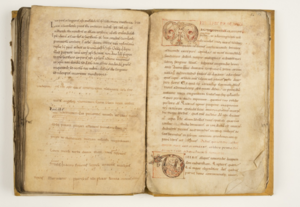Antwerpen, Museum Plantin-Moretus, M 82
| Library | Museum Platin-Moretus |
|---|---|
| Shelfmark | M 82 (66) |
| Century | s. XI-XII |
| Provenance | ? |
| General region of origin | Northeastern France (Benedictine Monastery St. André du Cateau?) |
| Collection | Quadripartitus |
| Author | Bruno Schalekamp |
Antwerpen, Museum Platin-Moretus, M 82 (66) is an eleventh and twelfth-century composite manuscript of 100 folios in 1 col. (253 x 165 mm). Its codicological composition reads as follows: 2 x IV16 + III20 + IV28 + (III-1)35 + IV43 + III49 + II51 + 5 x IV91 + (IV + 1)100, without quire signatures, and modern foliation in Arabic numerals. It is made up of three parts (I: fols. 1r-35v; II: 36v-51v; III: 52r-100r), which can be dated in the following way according to Kerff and Kéry: I: saec. XI-XII; II: saec. XII1; and III: saec. XII. Written in northeastern France, possibly at the Benedictine monastery St. André du Cateau near Cambrai based on signatures on fols. 1r and 50r referring to sancti Andree apostoli, it has been in possession of S’Coningsdale near Ghent (Val Royal) before 1584 for the last part based on the 15th century signature on fol. 100v (liber uallis regalis iuxa gandauum (?) ordinis cartusiensis). From 1650 onward, in possession of Balthasar Moretus’ (1574-1641) private library. It was written by various hands, mostly in late Caroline minuscule, some late medieval hands and scribbles in humanist minuscule.
Contents
The manuscript contains some canon law material (most notably the Quadripartitus and including some Pseudo-Isidorian material), patristic excerpts, prose (Persius' Satires), a Latin version of the Iliad, some songs, capitularia (Capitula Antwerpiensia) and a description of (probably) Anglo-Frisian runes.

Antwerpen, PM, 82 is a complex codex, which was used over a long period of time. It contains large and illuminated capitals with various artworks (see fol. 52r, posted here, for an impression). These include many marginalia from various historical periods. The late medieval and early modern marginalia give the impression Persius’ Satires was used in an educational context. The small grammatical explanations of basic Latin, as well as a glossary explaining the use of authorities - all of which were added (much) later - indicate readers were all too keen to understand which authors were responsible for the contents of the text.
| folios | texts |
|---|---|
| Front cover | |
| 1r | Various scribblings from different time periods. Includes the title: Liber sancti andree apostoli de castello si quis [...] abstulerit [...] furatus fuerit anathemata [...] fiat fiat. The tite is repeated in abbreviated form in the middle of the page |
| 1v-16r | Unknown author, here ascribed to Cornelius Nepos. The work is known as: Daretis phrygii de excidio Troiae historia (Meister) |
| 16r-v | Short verse on the age of men and animals. 12th century hand |
| 17r | Blank page |
| 17v-35v | Pindarus Thebanus: Ilias Latina. Educational translation of Homer’s Iliad |
| 36v-48r | Persius: Satires, I-VI. Filled with marginalia in Latin (and a few words in Greek) of mostly late medieval hands, some small notes by early modern hands in humanist minuscule |
| 48v | Three short texts. First a small commentary on Persius’ Satires, possibly an excerpt. Secondly, a small grammatical explanation of basic Latin, clearly intended for educational purposes. Thirdly, a glossary of three lines in humanist minuscule, explaining the various authorities used in Persius’ Satires |
| 49r | Twenty-eight cipher runes, strikingly similar to Anglo-Frisian Futhorc, in alphabetical order with explanation of use in Latin |
| 49v | Blank page. A few probationes pennae on the page from late medieval and early modern hands |
| 50r-51v | Various excerpts of pope Gregory the Great, Ambrose and Jerome |
| 51v | Cantus: Laus tibi Christe qui es creator. Cut short after femina criminis conscia... |
| 52r-90v | Collectio canonum Quadripartita (Quadripartitus), book 4, including prologue, and epilogue. |
| 90v-93r | Pre-Pseudo Isidorian recension of the epistle of pope Clemens to bishop Jacob of Jerusalem |
| 93rv | Capitula Antwerpiensia |
| 93v-94v | Ruotger of Trier: capitula episcoporum, four chapters |
| 94v-95v | Tenth Council of Toledo (656), canon 1 |
| 95v-100r | Various excerpts of patristic works and conciliar law. In two distinct hands from the twelfth century |
| 100v | Unknown cantus or canti and various probationes pennae |
| Back cover |
Literature
Denucé, Catalogue des Manuscrits (1927), p. 58-60; Graves, Limerick, ‘The Ogham Alphabet’ (1876), p. 443-472; De Ricci, ‘Inventaire sommaire’ (1910), p. 224; Kerff, Quadripartitus (1982), p. 15-18; Kéry, Canonical Collections (1999), p. 168; Kottje, ‘Eine Antwerpener Handschrift des Quadripartitus’ (1976), p. 65-67; Meister, Daretis phrygii, De excidio (1872), p. IX-X and 1-52; Oberleitner, Die nordischen Runen (1846), p. 39-40; Pertz, ‘Handschriftenverzeichnisse’ (1843), p. 566; Plessis, Italici Ilias Latina (1885), p. 3-85; Pokorny, ‘Zwei unerkannte Bischofskapitularien’ (1979), p. 487-513; Stein, ‘Les manuscrits’ (1886), p. 225; Vanderhaeghen, Notice (1875), p. 6-7
See also Michael Elliot's extensive work and draft editions of the Quadripartitus on his own website: http://individual.utoronto.ca/michaelelliot/.
